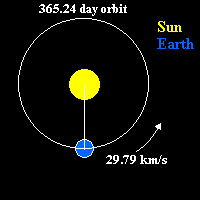
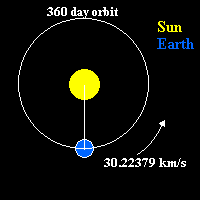 If we speed up the orbit of the earth to 30.22379 km/s we would end up with a
year that is 360 days long.
If we speed up the orbit of the earth to 30.22379 km/s we would end up with a
year that is 360 days long.360 Day Years - Fact or Fiction
Did the earth have a 360-day year with a 30-day lunar month within the last 3,000 years?
Our year is actually 365.2422 days and our lunar month (from new moon to new moon) is 29.531 days.
So why did early civilizations around the world use calendars with months of 30 days and years of 360 days? These calendars seemed to function well until sometime in the 8th century BC when suddenly it became necessary to change them. Most civilizations around the world began to modify their calendars to allow for 5 extra days for the year and 6 fewer days for a lunar year. A lunar year is 12 full months; a modern lunar year is 354 days (12 months x 29.5 days).
Were these early civilizations incapable of accurately measuring the astronomical cycles that governed their calendars prior to the 8th century?
The 8th century BC was a time between 799 BC - 700 BC. Let's look to the Bible in that period of time to see if we can find any changes mentioned. There are a number of books in the Bible that were written during this time. 2nd Kings, Amos, Hosea, Micah, Isaiah... In the book of Isaiah we find the story of the sundial going backwards.
This is the earliest mention of a sundial in historical literature.
Isaiah 38 tells us about Hezekiah king of Judah, a man near death, told by Isaiah to put his house in order because God told Isaiah that Hezekiah would die and not live. Hezekiah prays to God and God tells Isaiah that He has heard Hezekiah's prayer and will add 15 years to his life. God even says to Isaiah that He will give Hezekiah a sign that God will do this.
"Behold, I will bring the shadow on the sundial of Ahaz ten degrees backward." So the sun returned ten degrees on the dial by which it had gone down. (Isaiah 38:8)
This story is repeated in 2 Kings 20:1-11
How much time would this 10 degrees take?
360 degree circle (on the sundial), divided by 12 hours of sunlight (average day) = 30 degrees per hour
1/3 of an hour = 20 minutes
10 degrees would = 20 minutes.
Now a modern sundial is round and would only show a 180 degree change for 12 hours, but the sundials from this time were not round but a set of stairs that had two sides that stepped up towards each other and met in the middle. We don't know how many steps this particular sundial of Ahaz had. If it had 360 steps then 20 minutes could be an accurate estimate.
Why 360 steps? The Hebrew in Isaiah can be translated literally as steps (NIV) but it can also mean degrees (KJV), so if the meaning were 10 degrees then 360 degrees would = 360 steps.
A sundial positioned properly with 360 steps could tell you not only what hour of the day it was but also what day of the year it was (if the year had 360 days).
Some commentaries on this sign of the sundial going backwards have said that it could have been due to sun refraction. Would the creator of the universe give a sign that could be confused with natural phenomenon? These commentaries would be written by people of little faith.
Now this gets quite interesting:
The earth is orbiting the sun at 29.79 km/s (kilometers per second) and has been doing so for many thousands of years. This constant speed of 29.79 km/s means that to make one orbit of the sun (one complete circle) will take 365.2422 days.

 If we speed up the orbit of the earth to 30.22379 km/s we would end up with a
year that is 360 days long.
If we speed up the orbit of the earth to 30.22379 km/s we would end up with a
year that is 360 days long.
If we had a year of 360 days and slowed the orbit of the earth from 30.22379 km/s back to 29.79 km/s then the year would equal our current solar year; 365.2422 days per year.
The difference in speed between 365.2422 days per year and 360 days per year is equal to 20.9688 minutes per day. This is not a difference in our 24-hour time period but it would take the earth 20.9688 minutes less time per day to travel that same distance in the orbit around the sun.
365.2422 days -20.9688 minutes per day = 360 days
If you had a year = 360 days per year and slowed the orbit of the earth around the sun by 0.433792 km/s (The difference between 30.22379 km/s and 29.79 km/s), you would end up with a year that takes 365.2422 days. This slower speed would cause 5.2422 days extra per year to make one complete revolution around the sun.
There is no time dilation or anything extraordinary here. We have only slowed the speed of the earth down. We have not changed spin of the earth in a 24-hour period and we have not changed the speed of the moon around the earth.
However, if the earth had a year of 360 days per year (= earth's orbital speed of 30.22379 km/s) the moon would now automatically have a 30 day lunar month without changing the speed of the orbit of the moon!
Confused, let me elaborate.
With our modern calendar the Moon takes about 27.3 days to make one complete
orbit around the earth with relation to the stars.
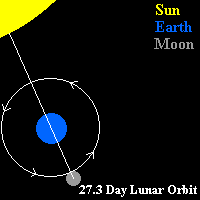
But the earth is also moving around the sun draging the moon with it. The earth
orbits around the sun once every 365.2422 days (= earth's orbital speed of 29.79
km/s). The earth and moon in 27.3 days have moved as a system about 1/12 of the
ways around the sun. This means that from one full moon to the next full moon,
the moon must travel 2.2 extra days before it appears full this is due to the
curve of the earth's orbit around the sun. The moon is still making one complete
orbit (circle) in 27.3 days, but to line up with the earth and sun to become a
full moon again it takes 29.531 days.
29.531 day lunar months x 12 lunar months = 354.372 days per lunar year
A difference of 10.87 days a year between a lunar year and a solar year of
365.2422 days per year.
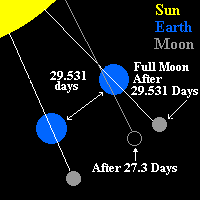
If we did not speed up the orbit of the earth but had our current speed of
29.79 km/s and let the earth travel half a day further, then after 29.9 days we
see that the moon has gone half a day past the full moon. (To achieve a full
moon the moon must be in a straight line with the middle of the earth and the
sun.)
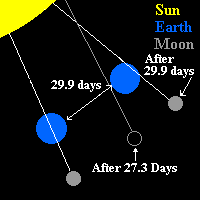
With a calendar of 360 days per year:
Now if we changed nothing else except to increase the speed of the earth's orbit
to 30.22379 km/s to achieve a 360 day year, then the time it takes from one full
moon to the next full moon would be 29.96785 days (30 days). The moon would
still be making one complete orbit every 27.3 days but the moon would now need
to travel 2.6785 extra days (added to the 27.3 days) to become full again.
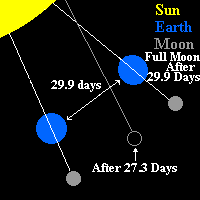
29.96785 day months x 12 months = 359.6142 days per lunar year
A difference of 9 hours a year between a lunar year and a solar year of exactly
360 days per year.
By adjusting the speed of the earth around the sun to give us a year of 360 days we automatically end up with a month that equals 30 days (29.96785 days). It just so happens that all ancient calendars had 12 - 30 day months, which equaled 360 days. These ancient calendars also had 1 solar year = 360 days!
All these 360-day solar/lunar year calendars suddenly begin to change in the 8th century BC to either a 365 day solar year or a lunar year of 354 days per year (or both). Which match our modern calendars.
In the 8th century BC, the Bible tells us the sun moved backward on a sundial, our calculations estimate that this distance on the sundial would equal about 20 minutes. A miracle so subtle you would only notice if you were watching a sundial.
The difference between 360-day year with a 30-day month and our 365.2422-day year with a 29.531-day month is orbital speed, which can also be translated into time, about 20 minutes extra per day.
We're not done yet
The Book of Enoch.
While doing this research I came across a reference to the Book of Enoch.
Enoch was the seventh generation from Adam. (Genesis 5:18-24)
The Book of Enoch is known as an "apocryphal" writing,
"Apocryphal" comes from the Greek word meaning "hidden" or "secret".
These apocryphal book's, were considered by some to be sacred and they were taught alongside the bible, both by the Jews and the early Christian leaders. These books were usually reserved for leaders and teachers only, leading to the term - secret.
In the 4th century AD some prominent church leaders decided that the book of Enoch should be destroyed, because they did not agree with some of the statements made in the text. So the Book of Enoch was pretty much wiped from the face of the earth, except for 3 copies that had survived (hidden) at a church in Ethiopia. These copies were found in 1773, which brought about the controversy on the date of origin for these copies.
The Book was once believed to be 1st century post-Christian in origin because of the similarities in some of the text.
Then they found the Dead Sea Scrolls at Qumran with ten fragments of Enoch manuscripts among the scrolls. Many of the Scrolls predate the Christian era by hundreds of years.
Part of the problem with the book may be that additions were added to any original copies owing to the confusion. Chapters 37-71 of the Ethiopian copies were probably added to the original after or during the time of Jesus since no fragments of these chapters were found with any of the Dead Sea Scrolls. There seem to be many similarities between the New Testament books and these chapters, which may indicate that they were written during or after the first century.
The only reason I give any mention at all the Book of Enoch is that the New Testament Book of Jude quotes from the Book of Enoch
Now Enoch, the seventh from Adam, prophesied about these men also
saying, " Behold, the Lord comes with ten thousand of His saints, to
execute judgment on all, to convict all of their ungodly deeds which they have
committed in an ungodly way, and of all the harsh things which ungodly sinners
have spoken against Him."
(Jude 1:14-15)
Compare this with:
And behold! He cometh with ten thousands of His holy ones To execute
judgement upon all,
And to destroy all the ungodly:
And to convict all flesh Of all the works of their ungodliness which they have
ungodly committed,
And of all the hard things which ungodly sinners have spoken against Him.
(The Book of Enoch 1:9)
The Book of Enoch in the Chapter 74 gives us some detailed astronomical data that does not match our current measurements.
We read in the Book of Enoch that a solar year = 364 days
A lunar year (12 months x 29.5 days) 354 days, falls behind a solar year by 10
days.
Enoch takes these calculations farther and states that in 8 years the moon falls
behind 80 days.
So a lunar year will fall behind a solar year by 80 days after 8 years.
With our current 365.2422 days per year and lunar year equal to 354.372 days, then in 8 years the moon will fall behind by 86.9616 days.
The Chart below shows difference between the solar year and lunar year if we are only speeding up the orbit of the Earth around the sun.
| Speed of Earth's Orbit | = | Days per Solar Year |
Days per Lunar Month |
Days per Lunar Year (12 lunar months) |
Days difference after 8 years |
| 29.79 km/s | = | 365.2422 | 29.531 | 354.372 | 86.9616 |
| 29.80977 km/s | = | 365 | 29.56651 | 354.79812 | 81.61504 |
| 29.89166 km/s | = | 364 | 29.63452 | 355.61424 | 67.08608 |
| 29.97401 km/s | = | 363 | 29.71785 | 356.6142 | 51.0864 |
| 30.05681 km/s | = | 362 | 29.80118 | 357.61416 | 35.08672 |
| 30.14007 km/s | = | 361 | 29.88452 | 358.61424 | 19.08608 |
| 30.22379 km/s | = | 360 | 29.96785 | 359.6142 | 3.0864 |
Would Enoch's 80-day difference be possible with a 364-day year using the same calculation?
| Speed of Earth's Orbit | = | Days per Solar Year |
Days per Lunar Month |
Days per Lunar Year (12 lunar months) |
Days difference after 8 years |
| 29.82 km/s | = | 364.81 | 29.567017 | 354.804204 | 80.0464 |
Again the moon is still making one rotation every 27.3 days in everyone of the above calculations. The differences are due to the speed of the earth's orbit around the sun.
If this part of the Book of Enoch was written by Enoch then the speed of the earth around the sun was 29.82 km/s during his time, which would equal a solar year of 364.81 days and a lunar month of 29.567017 days.
Enoch was the Great Grandfather of Noah. If parts of the book are genuine (authored by Enoch) then his observations were made before the flood.
Read what the Book of Enoch says about the coming judgement in Chapter 80:2
2 And in the days of the sinners the years shall be shortened,
And their seed shall be tardy on their lands and fields,
And all things on the earth shall alter,
And shall not appear in their time:
And the rain shall be kept back
And the heaven shall withhold (it).
3 And in those times the fruits of the earth shall be backward,
And shall not grow in their time,
And the fruits of the trees shall be withheld in their time.
4 And the moon shall alter her order,
And not appear at her time.
5 [And in those days the sun shall be seen and he shall journey in the
evening on the extremity of the great chariot in the west]
And shall shine more brightly than accords with the order of light.
6 And many chiefs of the stars shall transgress the order (prescribed).
And these shall alter their orbits and tasks,
And not appear at the seasons prescribed to them.
7 And the whole order of the stars shall be concealed from the sinners,
And the thoughts of those on the earth shall err concerning them,
[And they shall be altered from all their ways],
Yea, they shall err and take them to be gods.
8 And evil shall be multiplied upon them,
And punishment shall come upon them So as to destroy all.'
(The Book of Enoch 80:2-8)
Interesting how Enoch would make a prophecy that the years shall be shortened. Just by speeding up the orbit of the earth will fulfill the most of his above statements. Given enough time a 364-day calendar is going to be out by 4 days every year if the year was shortened to 360 days per year (verse 2). The moon will be 6 days different per year (verse 4).
During the time of the flood Noah tells us that a 150 days started on the
seventeenth day of the second month, and ended on the seventeenth day of the
seventh month (Genesis 7:11,24 and 8:3-4).
150 days divided by 30 days a month = 5 months
30 days x 12 months = 360 days
Did they have a similar 364-365 day year to our own at the time of Enoch
before the flood?
Did Enoch prophesize about the 360-day year that was to befall Noah's time?
Could this orbital speed change cause the biblical flood?
Do we embrace the Book of Enoch?
The answer to the last question is no. There could be parts of the book that may be written by Enoch. The problem is this - which parts? If chapters 37-71 were added during the 1st century then how much of the rest of the Book is tainted. There are also a number of areas of the book with which I have difficulty with.
Jude, (son of Mary and Joseph) the half brother of Jesus, quotes directly from one passage in Enoch. Is he quoting fiction or did Enoch really say that?
The detailed astronomical data in the book just happens to match precisely to the calculations with earth's orbital speed shifts. Until the time of Galileo this would have been guesswork at best. Copies of the astronomical text's portions of the book of Enoch were discovered with the Dead Sea Scrolls.
Without using this apocryphal writing - the Book of Enoch, is there a Biblical case for 365-day years before the flood?
In my last paper #X115 the data seems to indicate that God placed the life span limit on man to 120 years of 365 days per year. God made His decision 100 years before the flood in Genesis 6:3. Noah indicates that during the flood the year was 360 days long with 30-day months (Genesis 7:11,24 and 8:3-4). Then in Genesis 11:10 (2 years after the flood) there could be some confusion over which calendar to use 365 days per year or 360 days per year (see paper #X112).
This Biblical data seems to indicate that before the flood the calendar could have consisted of approximately 365 days per year. Then the years changed to 360 days per year - this would take some time to get use to which may account for the confusion in Genesis 11:10. Then the year again became our modern 365.2422 days per year - possibly in the 8th century as reflected in the calendar changes around the world at this time.
Isn't it strange how the story of Jehoiada and his long life span (see: #X115) only works with God's rule from Genesis 6:3, only if the years were equal to 365 days per year when the rule was made. This will only work if we account for Jehoiada's years past 120 as being added on by God for a time that is equal to the years Jehoiada hid Joash. Then we read the story in Isaiah 38, which tells us about God adding years to Hezekiah's life and using a miracle to prove it. That miracle and the calculations that surround it begin the discovery of a simple way (speed of the earth's orbit) of converting a 360 day year with a 30 day month to our modern 365.2422 day year with a lunar month equal to 29.531 days. Of course the Creator of the universe (God) is the only being capable of altering the speed of the earth's orbit faster or slower.
Interestingly enough earth may be headed for a 360-day year again!
Daniel 7:25 speaks about the last part of the tribulation with the Antichrist in power as lasting three-and-one-half years. The book of Revelation 11:2 and 13:5 describes the same period of time as being 42 months. Revelation 11:3 and 12:6 tells us that it is 1,260 days.
1,260 days divided by 42 months = 30 days per month.
42 months of 30 days per month = 3 1/2 years exactly of 360 days per year
To achieve a 30 day month the earth's orbit around the sun must be speed up so a year would = 360 days
Jesus speaking on the tribulation:
"And unless those days were shortened, no flesh
would be saved; but for the elects (chosen ones) sake those days will be
shortened.
(Matthew 24:22)
"But as the days of Noah were, so also will the
coming of the Son of Man be."
(Matthew 24:37)
Our Calendar of 365.2422 days per year x 3.5 years = 1278.3477 days
Revelations Calendar of 360 days per year x 3.5 years = 1260
This time period of 3.5 years would be shortened by 18.3477 days
By the way, according to the bible (Genesis 5:23,24)(Hebrews 11:5) Enoch did not die, but was taken (raptured) by God when he was in his 365th year.
This paper is Part 1 To goto Part 2 see:Isaiah's Sundial & Joshua's Long Day
© Copyright 1998, Trinity Consulting, All Rights Reserved.
![]()